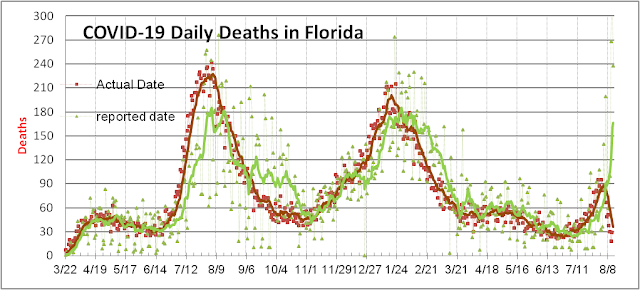COVID-19 Death Counts Reporting in FL Gets Less Transparent
The Florida Department of Health (FL-DOH) convinced the CDC to accept an alternative method for reporting COVID-19 cases and deaths this week that made things less transparent and more confusing at a critical junction of the pandemic. The FL-DOH has done well in tracking actual and reported dates for deaths and cases but now it has switched the two up in its reporting to the CDC and the public. The CDC appears to have accepted the new actual date reporting from FL without questions or explanations while most of the other 49 states are still sending the CDC “as reported date” information. At the end of the day, the two data series wind up in the same place because cumulative cases and deaths must total to the same numbers at all times, but in the interim, there is the potential for misleading conclusions and bad policies.
|
report date |
Cum case |
calc diff |
pre wk case |
cum death |
calc diff |
pre wk deaths |
|
12-Aug |
2,877,214
|
151,764 |
151,415 |
40,766
|
1,071 |
286
|
|
5-Aug |
2,725,450 |
134,751 |
134,506 |
39,695 |
616 |
175 |
|
29-Jul |
2,590,699 |
110,724 |
110,477 |
39,079 |
409 |
108 |
|
22-Jul |
2,479,975 |
73,166 |
73,199 |
38,670 |
282 |
78 |
|
15-Jul |
2,406,809 |
45,449 |
45,604 |
38,388 |
231 |
59 |
|
8-Jul |
2,361,360 |
23,747 |
23,697 |
38,157 |
172 |
32 |
|
1-Jul |
2,337,613 |
15,684 |
15,978 |
37,985 |
213 |
48 |
|
25-Jun |
2,321,929 |
11,048 |
11,873 |
37,772 |
217 |
44 |
|
18-Jun |
2,310,881 |
10,095 |
10,629 |
37,555 |
290 |
43 |
|
11-Jun |
2,300,786 |
12,157 |
37,265 |
40 |
Source: The bold numbers are those
reported by the FL-DOH (http://ww11.doh.state.fl.us/comm/_partners/covid19_report_archive/covid19-data/)
By going to the actual date of occurrence reporting, data for the previous days are continually updated in a non-transparent way. For example, the weekly FL-DOH report says the previous week’s deaths total 286 for the week ending August 12th (row 2, column 7 in table above). But the week’s total deaths can also be calculated by subtracting the previous week's cumulative total (39,695) from the current week's cumulative total (40,766) to get 1,071 additional deaths reported for the week ending in August 12th. The FL-DOH’s 286 is the actual number of people who died during that week AND were reported for that week, but this number needs to be continually adjusted as deaths sometimes take 2 months to verify in FL. Eventually, the 286 will grow to 1,000 - 1,100 as late death reports drift in. Similarly for FL-DOH to say the death count is 29 for August 12th (see last red dot on the graph below) may be technically correct but extremely misleading. Deaths in FL have not gone down over the last two weeks but are in reality rising. Every day this 29 number will grow but the growth may be concealed from public view. Without proper explanation, the public will be misled to draw the wrong conclusion about how to slow or end the pandemic.
The green curve would cause citizens and their government to become more alarmed and more vigilant about adopting sensible mitigation measures such as vaccines, masks, and social distancing. Rising cases and hospitalizations should have already convinced citizens to do the right thing, but many still argue that until cases result in death they are not concerned. The red curve might lead the casual observer to say things are not so bad and the government to say that further mitigations are not necessary. Because pandemics grow exponentially fast, every day’s delay in action now can result in hundreds of dead Floridians.
The problem is not confined to Florida because Florida has accounted for up to 20% of all US cases and still account for 20% of all US hospitalizations, it has an outsized effect on total US numbers. The declining death count in FL would soften the rising death count seen in every other state in the union, causing the CDC and the US government to adopt bad public health policies. It could lead other states such as Texas to say “if FL can do nothing and in fact still obstruct public health policies and do well maybe we can do the same thing”. Texas COVID-19 cases, hospitalizations, and deaths are soaring. Worse, they may adopt this Florida method of suppressing recent death counts and make themselves look better. (Something funky happened in California this week but it seemed to have been a one-time restatement; their death counts have resumed rising.) So we humbly request that the CDC reconsider this change and make Florida report deaths in the same way as every other state which would allow Americans and scientists access to the latest information in the most transparent and uniform fashion - otherwise, they must carefully explain why the entire data series needs to be downloaded every day and preserved to get the full picture



Comments
Post a Comment